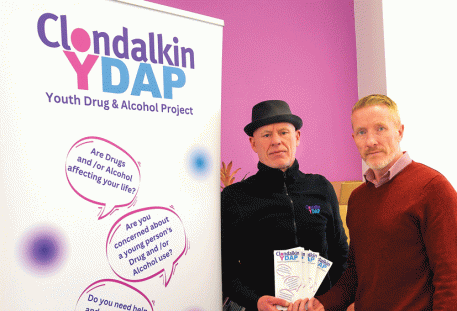Our Community
-
History of Clondalkin
Clondalkin is a suburban town situated 10 kilometres west of Dublin city centre within the administrative jurisdiction of South Dublin. It is one of three new western Dublin towns proposed in the Myles Wright Report to cater for the growing population of the Dublin region at the time. The other proposed towns were Tallaght and Blanchardstown. The vision for these new towns was that they would be partially self-sufficient communities.
During the early 1970s and 1980s these towns experienced rapid growth in population, continuing to this day. This growth was fuelled by a demand for low-cost housing, the decentralisation of industry from Dublin city, and the development of industrial infrastructure. This growth was not without issues and areas of Clondalkin came to be severely affected by poverty and social disadvantage.
The centre point of Clondalkin is its historic village which features a round tower dating from the 8th century. The village is bordered by the neighbourhoods of Surleen and Knockmitten. To the north of the village is the Grand Canal. Beyond the canal are the neighbourhoods of Quarryvale, Rowlagh, Neilstown and Balgaddy. To the south and west of the canal the neighbourhoods of Bawnogue, Deansrath and Clonburris can be found.
Early Demographic Profile
It is over 30 years since the 1991 Census which recorded a very high percentage of young people relative to other age groups residing in Clondalkin. At the time, 37% of the population were aged 1-14 years and only 3% of the population were over 65. Also, at this time it was reported that households headed by lone parents made up 17.9% of households in Clondalkin. There were few employment opportunities at the time which was reflected by a high unemployment rate. As a whole, the Clondalkin unemployment rate was 26% but this was as high as 44% in some areas. A damaging pattern of early school leaving was also evident in the 1991 census that reported that 40% of the population in Clondalkin left school at the age of 15 or under.
Emergence of Opiate Use and Community Response
Much of Dublin experienced a large increase in opiate use during the 1980’s peaking around 1985 (6). At the time the problem was overwhelmingly concentrated among young males between 15 – 24 years old. Though initially associated with inner city neighbourhoods the ‘opiate epidemic’ also reached out to the newly established suburb of Clondalkin.
In the early days the heroin problem in Clondalkin was mainly situated in North Clondalkin. Community groups in the Quarryvale area of North Clondalkin emerged and were instrumental in establishing Clondalkin Addiction Support Programme (CASP) as a grass roots response to the growing problem of heroin use in the area. Needs related to opiate use also emerged in Southwest Clondalkin at a later stage.
The Clondalkin Drug and Alcohol Task Force was established in 1997 as a statutory response to the issues associated with opiate use. It was one of 14 Local Drugs Task Forces established by the Government in response to the heroin epidemic occurring mainly in the Dublin region. The aim of these Task Forces was to take a partnership approach to complex issues and provide locally appropriate responses.
Since then, problematic drug use in Ireland has changed significantly and while heroin use remains a significant problem there is growing public concern regarding problems associated with polydrug use including cannabis, cocaine, alcohol and prescribed drugs such as benzodiazepines and other Z drugs.
Catchment Area and Strategy Response
Clondalkin Drugs Task Force serves Clondalkin and the surrounding areas of Lucan, Palmerstown and Newcastle. These areas form the Dublin Mid-West Dail constituency with a population of 117,976 in 2016.
To date, the CDATF has developed three local area strategies. Under our current strategy, the CDATF aims to respond to drugs and alcohol issues, work with all stakeholders and improve the coordination and delivery of services in the area. This strategy was developed with local stakeholders to synthesise the views and needs of the local community with the goals of the government’s national drugs strategy Reducing Harm, Supporting Recovery. It is delivered on through the work of local service providers in partnership with the community, voluntary and statutory sectors.
Overview
In our Community section you can find out about the History of Clondalkin, Early Demographic Profile, Emergence of Opiate Use and Community Response, our Catchment Area and Strategy Response.
Find out MoreOur Aims
Our mission is to re-establish and strengthen the role of the community in tackling the causes and consequences of drug and alcohol misuse facilitate the re-establishment of meaningful and effective partnerships; and support the development of a holistic approach to dealing with both the causes and consequences of drug and alcohol misuse in the CDATF area. Click below for more info on our values and goals.
Find out MoreOur Organisation
In our Organisation section you can find out more about our team and view details on our organisational structure. Click on the button below to find out more.
Find out MoreLatest News
- Pinned

Drive Project
Drug related intimidation and violence is a serious and frightening problem that is affecting individuals,... - Pinned

#kickthevape vaping campaign
#kickthevape Background In Ireland over recent years there has been a significant increase in the... 
Youth drug and alcohol project plays a huge role in community
“THERE is a huge need for the Youth Drug and Alcohol Project (YDAP) service, we...
Training
Find Out MoreWe provide a variety of training programmes around addiction, drug and alcohol support to schools, community workers and healthcare professionals.